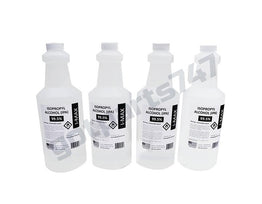When you want to protect your hands and skin from contact with potentially hazardous fluids, you reach for gloves. Nitrile gloves are a popular choice in the healthcare, cleaning, manufacturing, and automotive industries as well as in all types of repair and maintenance work. Why is this so? And does it matter what type of nitrile glove you use among the different thicknesses and colors available?
In this post, we’ll examine the difference between nitrile and latex gloves. We’ll also talk about which glove you should choose for different jobs. Finally, we’ll explain what all those colors and thicknesses mean.
What Are Nitrile Gloves?
Nitrile gloves are a type of disposable rubber glove made from nitrile – a synthetic rubber that’s resistant to oils, acids, alkalines, and heat. The same nitrile rubber material is also used to make hoses, seals, and other vehicle, machine, and airplane parts that have to withstand high temperatures and a lot of wear.
Nitrile gloves are durable and safe for a wide range of uses. You’ll find them in paint shops, restaurants, doctor’s offices, auto repair facilities, chemistry labs, vet offices, on construction sites, and at commercial printers and dyers, among many others. Hobbyists (and anyone with an at-home medical kit) also probably have at least a few pairs of nitrile gloves lying around the house.
Nitrile Gloves vs. Latex Gloves
For many years, latex gloves were commonly used in medical and healthcare settings. Latex gloves are thinner and fit closer to the skin; this gives them superior dexterity. And latex is made from a natural source, so it’s biodegradable. Finally, these gloves provide protection from biohazards like bacteria and viruses.
On the downside, latex gloves can trigger latex allergies. Healthcare workers and others who regularly use latex gloves can develop a sensitivity to them that may turn into a latex allergy. Latex gloves are also less durable than nitrile gloves and offer little protection against chemicals.
Nitrile gloves, on the other hand, are thicker; this makes them less dexterous but more resistant to strong chemicals. For all but the very finest work, this increase in thickness doesn’t affect job performance. Nitrile gloves are also much more puncture-resistant than latex gloves. And they’re not made with latex itself, which removes the allergy concern. Also, nitrile gloves are available in powder-free, polymer-coated, and smoothing chlorinated finishes; this can make the gloves easier to put on and take off while eliminating the potentially irritating powder particles of some latex gloves.
The major downside to nitrile gloves is the cost – they’re more expensive than latex. However, because of the removal of the latex allergy concern, many medical and healthcare providers have switched to nitrile gloves.
When to Use Nitrile Gloves
When should you use nitrile gloves? For starters, in any of the following situations (and this isn’t a complete list):
- When you need to protect your hands from chemicals or abrasive substances.
- For food safety.
- To protect your hands from human or animal waste, environmental contaminants, etc.
- If you need something with greater tear strength than latex.
- If you need to know right away when a glove is breached. (It’s easier to spot damage in nitrile gloves than in latex gloves.)
- To prevent latex allergies or sensitivity.
- When a material safety sheet or similar guide recommends their use.
It’s good to know there are different types and thickness of nitrile gloves. Some gloves are specifically manufactured for medical or industrial uses; others are extra-thick for additional protection against chemicals and other hazards.
Nitrile Glove Colors
Is there any meaning to the different colors of nitrile gloves? A reason that one color might be preferable to another? In short: it’s all in the eye of the beholder.
While certain professions might prefer one color over another – the medical industry often uses blue, while maintenance personnel might use a very bright color for enhanced visibility – there’s no hard and fast rule about colors and glove types. The closest you’ll get is that nitrile glove manufacturers might use different colors for different grades of glove, such as our textured blue nitrile gloves or our stronger and thicker black mamba nitrile gloves.
Versatile Nitrile Gloves Keep You Safe
Nitrile gloves are comfortable, flexible, and durable barriers to various hazardous (or just gross) substances. They not only protect the wearer, they can also protect others by keeping infectious agents contained. As such, it’s no wonder that they are an essential tool across industries, geographies, and households.

